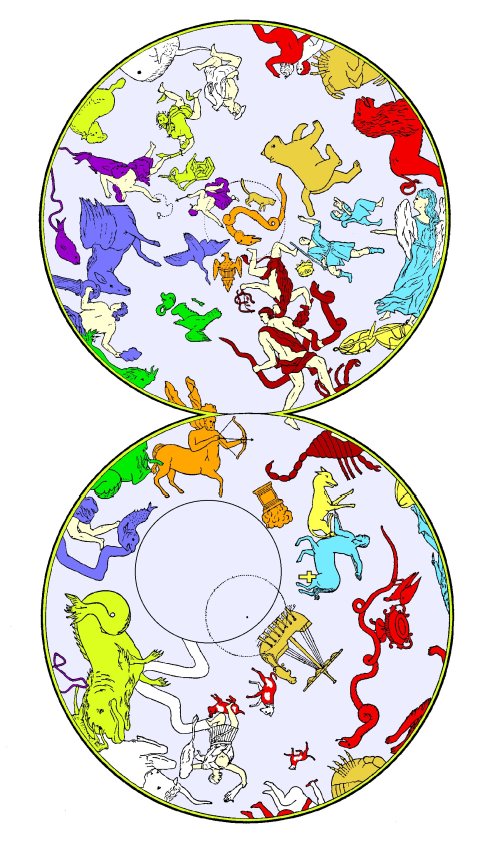
by John P. Pratt 24 Dec 2015 (11 Storm)
©2015 by John P. Pratt. All rights Reserved.
| 1. Ancient Constellations |
| 1.1 Aratus |
| 1.2 Ptolemy |
| 1.3 Persia |
| 2. Proposed List of 48 |
| 2.1 The Infant Prince |
| 2.2 The Southern Cross |
| 2.3 The Wreath |
| 3. Arrangement into Decans |
| 4. Conclusion |
| Notes |
 |
Our modern list of constellations derives almost entirely from the ancient Greeks. There is a tradition that Pythagoras (570-495 BC), the famous Greek mathematician and philosopher for whom the Pythagorean Theorem is named, spent several years in Egypt. He is said to have even been a temple priest and learned much of his math and science there. There is also a tradition that he brought back to Greece a sphere on which were shown the constellation figures. Such spherical sky maps are readily available today. Any work that Pythagoras might have done regarding the constellations has not survived.
Over a century later, that same spherical map of the heavens came into the possession of another Greek mathematician and astronomer Eudoxus (408-355 BC) who wrote a commentary on the constellations. He was Plato's student. Unfortunately all of the work of Eudoxus has also been lost.
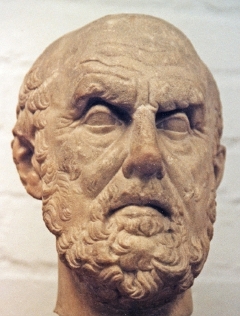 |
Aratus tells us something about each constellation. He does not number them and the total number is not clear because two parts of a constellation could be counted as separate. For example there is a Serpent Bearer who is holding a Serpent. He describes both. There is also an Archer holding a Bow. Because all other lists count the Serpent and Serpent Bearer as two constellations and the Archer and his Bow as one, the same is done in this article.
His list matches all the other lists in this article with the exception that he lists (1) the Triangle and (2) the little circle of stars at the forefeet of the Archer known to us as the Southern Crown. A brief summary of his descriptions of all of the constellations can be downloaded here as a Constellation Spreadsheet file.
While Aratus described the figures he saw, he did not attempt to explain just where these figures were in the sky. Aratus was a poet, not an astronomer. He poetically described what many people were already familiar with. Thus, the record is only partially useful in identifying just what stars were considered to be in which figures.
| Col. | Contents |
|---|---|
| A | Ptolemy Number |
| B | 3-Letter Abbreviation |
| C | Latin Name |
| D | English Name |
| E | Pratt Number |
| F | Persian? |
| G | Ancient Description |
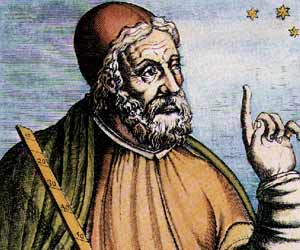 |
The list of Ptolemy contains exactly 48 constellations. His list is identical to that of Aratus with the exception that it has one more constellation: the Foal or Little Horse (Equuleus). That constellation is composed of 4 barely visible stars which seems totally out of place with all of the others. It appears to have been invented solely to complete the list of 48 and is usually ascribed to having been added by Ptolemy.
In modern times another 40 constellations have also been added to the original set. A complete list of all 88 modern constellations along with the descriptions of the first 48 by Aratus and numbering of Ptolemy can be downloaded here as a Constellation Spreadsheet file. A description of the spreadsheet columns is given in Table 1.
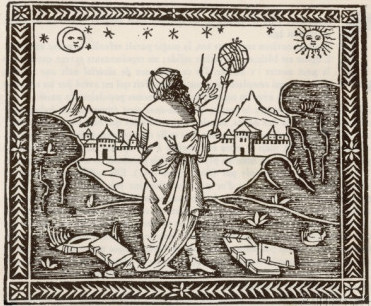 |
Comparing the 48 constellations of the Persian list to that of Ptolemy leads to several notable differences. In her book Mazzaroth, Frances Rolleston (AD 1781-1864) analyzed the lists of several ancient peoples and produced her list of the 48 ancient constellations.[4]
In my articles so far, I have followed Rolleston's list which was based mostly on fitting Ptolemy's constellations into the Persian arrangement of decans.[5]
One of the purposes of this article is to now correct what I believe to be a mistake in her conclusions. The Persians separated the Fishes (Pisces) into two separate constellations: The Fishes and the Bands which secure them to the Sea Monster (Cetus). It now appears to me that they were separated only so that they would have the desired total of 48. Everything about the Fishes suggests that it is a single constellation, even as the Archer (Sagittarius) and his Bow.
If the Bands and Fishes are all one constellation, then what is the other constellation? It seems reasonable to assume that each of the ancient cultures might have had a copy of some original list. Over time, different nations might have lost different constellations. The Persians and Egyptians retained the Infant Prince and the Scales whereas both were missing from the Greek lists. So let us look at both what constellations had been lost to the Greeks and also what constellations were on the Greek lists which might have been lost to the Persians.
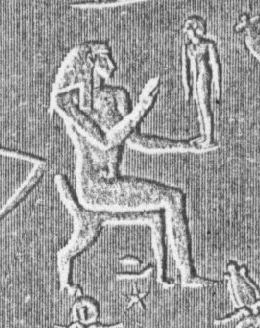 |
In 1893, E.W. Bullinger noted that the constellation is shown on the Egyptian planisphere at Dendera.[6] That was a huge find because it both supplied a second witness from another ancient nation to the existence of such a constellation, as well as confirmed the area of its location and provided an illustration of how it looked (See Figure 3).
In the Egyptian version, it is the goddess Isis holding the infant god Horus. Using the figure from the temple at Dendera as a guide, in my work the precise stars included in the Infant Prince have been identified.[7] The actual stars in the sky match the figure so well that there is little doubt that it has been correctly identified. It is composed of at least one fairly bright star in the midst of a large area of sky where there is an obvious gap in the constellation figures. It is large enough that two modern constellations were invented to fill that space: the Hunting Dogs (Canes Venatici) and Berenice's Hair (Coma Berenices).
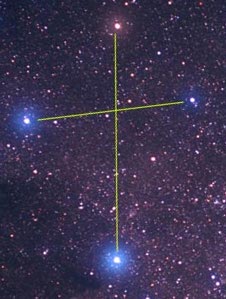 |
The Southern Cross used to be visible in the northern skies up until about the time of Christ, at which time they set due to the slow shifting of the heavens known as the precession of the equinoxes. Hipparchus could still see them and listed them as part of the constellation of the Centaur. He also saw only the Claws of the Scorpion in the place of Libra. It is not difficult for constellations to be lost.
Rolleston included the constellation of the Southern Cross on her list of 48. It was justified by her showing that it was included in some ancient lists such as that of Rabbi Aben Ezra (AD 1089-1167) long before it was added to the modern lists.[8] Richard Allen in his Star Names, the Lore and Meaning reports that some world explorers knew that it had been known to the ancient Persians.[9] When it disappeared they replaced its symbolism at feasts with the Dolphin.
Thus, it is still proposed that the Southern Cross was one of the original constellations, consistent with all of my earlier work.
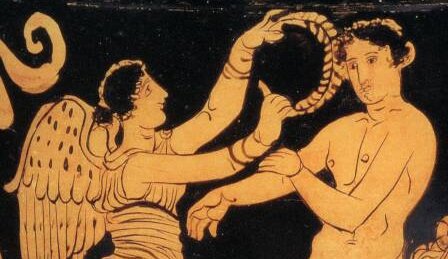 |
Two constellations which Ptolemy includes not found on other lists are the Triangle (Triangulum) and the Southern Crown (Corona Australis). Both of those are on the list of Aratus, but the Triangle is given an explicit name whereas the Crown is described only as a little circle of stars. To me that does not discount the Southern Crown from being authentic because Aratus was not looking at the sky, but rather at a map or globe (which had colored illustrations). Remember that whoever made the globe had already lost some of the figures. The Southern Crown could have been in the process of being lost.
 |
On the other hand, the Southern Crown was described by the Greeks as a wreath, as was given to victors of sporting events such as the Olympics and is still associated with such prowess. It also represented the victories of heroes. Although it does not have explicit myths, it fits into the general themes and motifs of the other constellations.
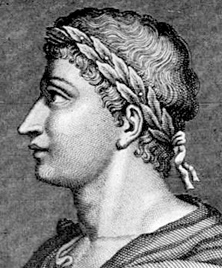 |
Thus, it is here proposed that the Wreath (Southern Crown) be considered as one of the original constellations, until more information becomes available. This has always been a work in progress.
In all of my earlier work, the order of the 36 decans which accompany the 12 zodiac constellations was taken from the arrangement reported by Albumazar and interpreted by Frances Rolleston. She had done much research and I saw nothing better.
Now that it is proposed that the Fishes and Bands are only one constellation and that the Wreath should fill the gap created thereby, it opens the door to ask exactly why each of the three decans in the Persian list which she used were ordered as they were. In the Egyptian versian of the decans it seems that their order was determined by the actual order of stars rising, so that each marked a ten-day period. We are not sure what their decans were and the Persian list is not organized in that manner.
One of Rolleston's main points and of those who followed her lead was that the decans seemed to be arranged in a way to tell the story of Jesus Christ. Several books have been written to that end and the suggestion seems to have much merit. Until now that theme has not been questioned in my work, although different interpretations were suggested.
It is here proposed that the order of the decans can be determined almost entirely on purely astronomical grounds. That way they are allowed to tell their own story better rather than being arrange to fit one person's understanding of the gospel.
Here are my proposed criteria for arranging the 36 decans and associating each with one of the 12 zodiac constellations in a 4x12 table:
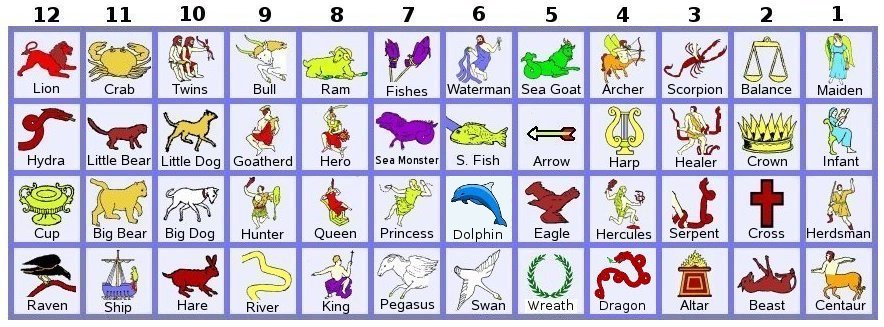 |
Interactions and shared stars were used to arrange the rows of each column. The Maiden is identified as the virgin queen holding the Infant who grows up to be the Herdsman (Bootes). All eight constellations adjacent to the Cross have interaction with it (such as Moses, a Herdsman, putting the serpent on the Cross). The Centaur is slaying the Beast (Lupus) which is sacrificed on the Altar (Ara). The Healer (Serpent Bearer, Ophiuchus) is crushing the head of the Scorpion. The Serpent (Serpens) is reaching for the Crown (Corona Borealis). The Healer (Hermes) invented the Lyre (Harp, Lyra). Hercules is crushing the head of the Dragon (Draco) and wins the Wreath. The Dragon is identified with the Serpent which in turn is identified with the Scorpion (both having heads crushed). The Archer is shooting the Arrow (Sagitta). The Eagle (Aquila), Swan (Cygnus), Dolphin (Delphinus) and Pegasus all fly in the heavens area (north of zodiac). The Dolphin is a transition from fish (in watery underworld below the zodiac) to birds above in the heavens, so it between the Southern Fish (Piscis Austrinus) and the Swan. The Waterman (Aquarius) is pouring water onto the Southern Fish. The bands of the Fishes are connected to the Sea Monster. That monster is also part of the myth of the Hero (Perseus), Princess (Andromeda), King (Cepheus) and Queen (Cassiopeia). The King and Queen are the parents of the Princess and so are adjacent to her, and the Hero kills the Sea Monster so they have major interaction. The Big Dog (Canis Major) and Little Dog (Canis Minor) belong to the Hunter (Orion) and together they hunt the Hare (Lepus). The River (Eridanus) begins at the foot of the Hunter where they share the bright Star Rigel. The Big and Little Dogs may correspond to the Big and Little Bears. And finally, the Lion (Leo) is crushing the head of Hydra, the Fleeing Serpent, and the Cup (Crater) and Raven (Corvus) both share a star or two with her back.
It is proposed the ancient constellation of the Wreath (Southern Crown, Corona Australis) was indeed one of the original 48 constellations just as the Greek astronomer Ptolemy implied. It has been omitted in former lists published in my articles, which listed the Bands and the Fishes (Pisces) as separate constellations, following the Persian understanding. Thus, my current proposed list of 48 is identical with that of Ptolemy with three exceptions: his constellations of the Claws (of the Scorpion), the Little Horse, and the Triangle are replaced by the more ancient constellations of the Balance, the Southern Cross, and the Infant Prince.
In the process of rearranging the table of 48 constellations, composed of 12 zodiac constellations, each having three associated decan constellations, three rules are herein proposed describing how the constellations should be arranged in that table. Each constellation should be 1) within the column of the zodiac constellation it is above or below (in longitude) or an adjacent column if not possible, 2) be adjacent to a constellation sharing a star with it, and 3) be adjacent to any constellation it has interaction with. The resulting table of the arrangement of 48 constellations proposed to be the original set is shown in Figure 4.
The title of this article implies that it is a work in progress. For example, it could turn out that the Serpent Bearer and the Serpent should be counted as one rather than two constellations. The Triangle may indeed have been in the original set. Perhaps the Seven Sisters (Pleiades) should be counted separately from the Bull (Taurus), or perhaps some other constellation has been entirely lost.
The fact that the table shown in Figure 4 fits together so neatly to display symbolism and interaction and that all elements contain symbolism of Jesus Christ is compelling evidence that these amazing constellations were carefully designed as a set. This evidence supports the claim that the figures were revealed by an angel to the prophet Enoch. Every effort should be made to discover the original set and understand their witness of God and of the gospel of Jesus Christ.